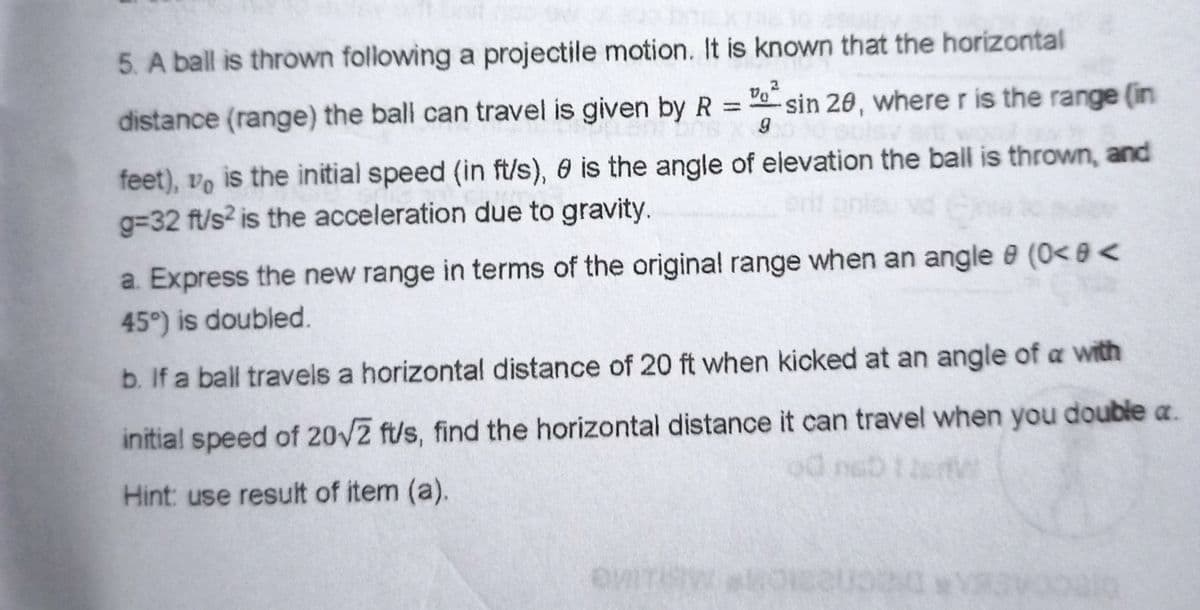5. A ball is thrown following a projectile motion. It is known that the horizontal distance (range) the ball can travel is given by R Do sin 20, where r is the range (in %3D feet), vo is the initial speed (in ft/s), 0 is the angle of eievation the ball is thrown, and g=32 ft/s? is the acceleration due to gravity. a. Express the new range in terms of the original range when an angle e (0< 8< 45°) is doubled. b. If a ball travels a horizontal distance of 20 ft when kicked at an angle of a with initial speed of 20/2 ft/s, find the horizontal distance it can travel when you double a. od neb 1ertu Hint: use result of item (a).
5. A ball is thrown following a projectile motion. It is known that the horizontal distance (range) the ball can travel is given by R Do sin 20, where r is the range (in %3D feet), vo is the initial speed (in ft/s), 0 is the angle of eievation the ball is thrown, and g=32 ft/s? is the acceleration due to gravity. a. Express the new range in terms of the original range when an angle e (0< 8< 45°) is doubled. b. If a ball travels a horizontal distance of 20 ft when kicked at an angle of a with initial speed of 20/2 ft/s, find the horizontal distance it can travel when you double a. od neb 1ertu Hint: use result of item (a).
College Physics
11th Edition
ISBN:9781305952300
Author:Raymond A. Serway, Chris Vuille
Publisher:Raymond A. Serway, Chris Vuille
Chapter1: Units, Trigonometry. And Vectors
Section: Chapter Questions
Problem 53P: A surveyor measures the distance across a straight river by the following method: starting directly...
Related questions
Question

Transcribed Image Text:5. A ball is thrown following a projectile motion. It is known that the horizontal
%3D
distance (range) the ball can travel is given by R = sin 20, where r is the range (in
feet), vo is the initial speed (in ft/s), 0 is the angle of elevation the ball is thrown, and
g=32 ft/s2 is the acceleration due to gravity.
a. Express the new range in terms of the original range when an angle e (0< 0 <
45°) is doubled.
b. If a ball travels a horizontal distance of 20 ft when kicked at an angle of a with
initial speed of 20/2 ft/s, find the horizontal distance it can travel when you double a.
neb
Hint: use result of item (a).
Expert Solution
This question has been solved!
Explore an expertly crafted, step-by-step solution for a thorough understanding of key concepts.
This is a popular solution!
Trending now
This is a popular solution!
Step by step
Solved in 3 steps with 5 images

Knowledge Booster
Learn more about
Need a deep-dive on the concept behind this application? Look no further. Learn more about this topic, physics and related others by exploring similar questions and additional content below.Recommended textbooks for you

College Physics
Physics
ISBN:
9781305952300
Author:
Raymond A. Serway, Chris Vuille
Publisher:
Cengage Learning

College Physics
Physics
ISBN:
9781285737027
Author:
Raymond A. Serway, Chris Vuille
Publisher:
Cengage Learning

College Physics
Physics
ISBN:
9781938168000
Author:
Paul Peter Urone, Roger Hinrichs
Publisher:
OpenStax College

College Physics
Physics
ISBN:
9781305952300
Author:
Raymond A. Serway, Chris Vuille
Publisher:
Cengage Learning

College Physics
Physics
ISBN:
9781285737027
Author:
Raymond A. Serway, Chris Vuille
Publisher:
Cengage Learning

College Physics
Physics
ISBN:
9781938168000
Author:
Paul Peter Urone, Roger Hinrichs
Publisher:
OpenStax College

Physics for Scientists and Engineers with Modern …
Physics
ISBN:
9781337553292
Author:
Raymond A. Serway, John W. Jewett
Publisher:
Cengage Learning

Physics for Scientists and Engineers
Physics
ISBN:
9781337553278
Author:
Raymond A. Serway, John W. Jewett
Publisher:
Cengage Learning

Physics for Scientists and Engineers: Foundations…
Physics
ISBN:
9781133939146
Author:
Katz, Debora M.
Publisher:
Cengage Learning